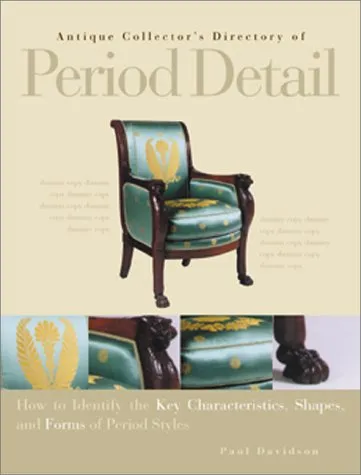Antique Collector's Directory Of Period Detail: How To Identify The Key Characteristics, Shapes, And Forms Of Period Styles
By (author): "Paul Davidson"
ISBN0764151673
ISBN139780764151675
AsinAntique Collector's Directory Of Period Detail: How To Identify The Key Characteristics, Shapes, And Forms Of Period Styles
Original titleAntique Collector's Directory of Period Detail: How to Identify the Key Characteristics, Shapes, and Forms of Period Styles
Handsome full-color photos, informatively labeled line drawings, and an enlightening text show readers how to identify antique chairs, tables, bureaus, case furniture, coffee pots, teapots, silverware, candlesticks, glassware, and porcelain pieces according to the historical period of their origin. The key to identification lies in recognizing an era's representative shapes and matching those shapes to the antique being examined. Fine examples of European and American craftsmanship spanning three centuries are shown and discussed, starting in the mid 1600s and progressing to the 1930s. Illustrations show how basic furniture styles were derived by copying and scaling down dominant architectural shapes of the day, then how artisans in different countries added their own distinctive touches. The authors advise collectors on what to look out for when buying an antique, then tell how to detect any repairs, and know whether or not a repair affects the piece's value. Historical periods discussed in detail present detailed information on -- -- Baroque to Rococo (mid 1600s to late 1700s) -- ornate styles and shapes from Continental Europe, and how typical pieces compare with the more restrained styles in England and North America-- The difference between 18th-century Rococo and its revival, approximately a century later-- The Chippendale story -- an overview of the furniture, and how its lines translated into glassware, ceramics, and silverware-- Neoclassical style -- the heavy forms exemplified by the Empire style in Napoleonic France, Beidermeier in Germany and Austria, Regency in England, and Federal in America-- The Machine Age -- mass production, new materials, newprecision in form and decoration, and Art Nouveau innovations by Tiffany and other leading designers-- Art Deco -- including pieces by Georg Jensen, Lalique, the Weiner Werkstatte, and much moreEach of this volume's historical chapters contains a Shape Identifier section, clearly and simply illustrating the period's dominant lines and shapes. Beautifully photographed room settings capture the mood of each period.
